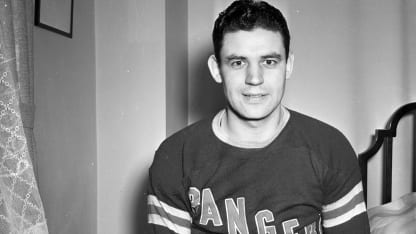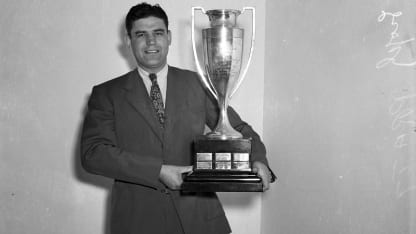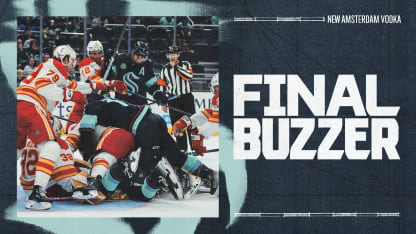Pratt mixed skill, sense of humor on way to Hockey Hall of Fame
Pratt mixed skill, sense of humor on way to Hockey Hall of Fame
Defenseman kept teammates laughing, won Cup with Rangers, Maple Leafs

Legendary hockey reporter Stan Fischler writes a weekly scrapbook for NHL.com. Fischler brings his humor and insight to viewers every Wednesday.
This week he reports on a defenseman who not only was revered for his excellence on the ice but also for his sense of humor both on and away from the rink.
Walter “Babe” Pratt was an extraordinary defenseman during the late 1930s and ’40s. He won the Hart Trophy with the Toronto Maple Leafs in 1943-44 as well as being named to the First All-Star Team. He scored Toronto’s Cup-winning goal a year later as a Second All-Star and was inducted into the Hockey Hall of Fame in 1966.
“Had there been a Norris Trophy at the time,” wrote Toronto Globe and Mail sports columnist Dick Beddoes, “he also would have been crowned the league’s best defenseman.”
During Babe’s 11-year National Hockey League career, he was both admired for his skill and his sense of humor as well. Author of “Hockey’s Greatest Stories,” Beddoes was one of many journalists who would seek Pratt for a laugh as much as a story.
“Babe roamed the defense of the Rangers, Leafs and Bruins,” Beddoes recalled, “blithe and irreverent, the mayor of Fun City. Reporters seeking laughs would come to Pratt because they knew he’d never fail them. He truly was a wild one; not unlike baseball’s Babe — Ruth!”

A Rangers beat writer once observed, “Pratt knew the emergency exit in every hotel in New York!”
Babe’s targets during those low-paying Great Depression years often were tight-fisted hockey executives. One of them was his Rangers boss Lester Patrick. The Silver Fox discovered and signed the big fellow from Stony Mountain, Manitoba, and eventually bumped heads with Babe.
When Pratt came to New York, Patrick gave his tall defender a contract for $2,500 a season. Peeved beyond belief by the low-balling, Babe decided to turn the Rangers manager’s frugality into a joke.
“Lester,” Pratt liked to say, “wouldn’t give a worm to a blind robin!”
Or, making certain he was out of Lester’s hearing range, Babe blurted, “Lester isn’t close or tight, but he’s gosh darn adjacent.”
Of course, Patrick had no complaints. He was able to curb Babe’s enthusiasm through the 1939-40 season when his ebullient blue liner helped the Rangers to the club’s first Stanley Cup in seven years and third overall for the franchise.
But by 1942, Patrick had suffered enough of Babe’s whimsy and traded him to Conn Smythe’s Maple Leafs for Hank Goldup and Red Garrett. While Smythe’s military manner intimidated some Leafs players, not Babe. He merely made a burlesque of them.
“Conny liked to give us the old ‘win-it-for-my-daddy’ bit,” Pratt said. “One night he said, ‘Gentlemen, my dear old daddy is down in the dumps. He’s dying! Nothing would save him better for the Leafs than to go out there and fight, fight, fight! Win, win, win for my dear old daddy!'”

The Leafs were routed that night whereupon Pratt’s sidekick, Hall of Famer Sweeney Schriner leaned over in the dressing room and tenderly intoned, “Yessir, Babe, we sure knocked off Smythe’s old man tonight!”
Apart from hockey, Smythe’s passion was horse racing and at one point, he had an admirable stable. One of Conn’s favorites was called Shoeless Joe, who would start slow and then come on strong to win.
“Gentlemen,” Smythe told his team at a morning meeting, “Shoeless Joe is my kind of hockey club.”
Hearing that, Babe turned to forward Bob Davidson, who was sitting next to him and whispered, “Which end of the damn horse are you?”
Had Smythe heard the quip, he likely would have laughed it off because he appreciated Babe’s skill set.
Before retiring from managing, Conn said, “I had Red Horner, and Gus Mortson and Tim Horton on defense but Pratt may have been the best defenseman I ever had.”
Maple Leafs forward Tom “Windy” O’Neill claimed that Babe never was better than during the second half of the 1944-45 season. “You never saw a guy stand the League on its ear in the last half of ’44-45 like Babe did,” O’Neill said. “He gave Flash Hollett of Detroit a hell of a run for high-scoring defenseman and finally beat him.”
Babe stopped joking during the 1945 Stanley Cup final against the Red Wings. The series went seven games with the climax at Olympia Stadium in Detroit on April 22. The score was tied 1-1 late in the third period when Pratt snared the puck.
“I skated in from the point, made a double-pass to Nick Metz and received it back on my stick,” Pratt said. “I slid a long one into the corner of the net past Harry Lumley and it turned out to be the Cup-winning goal. We beat ’em, 2-1.”
Beddoes said, “Babe did some serious celebrating after that but he also exercised a gift nearly unique in hockey. His gift was burlesquing hockey with the skill of a satirical comic while playing the game as well as any defenseman anywhere, at any time.”
Well into retirement, Pratt became a goodwill ambassador for the Vancouver Canucks. During each game, he brought his humor to the press box before a heart attack ended his life while he was watching a game. At the Canucks next game, his media pals rose and offered a toast to their dear, departed pal.
The Vancouver Sun’s Archie McDonald summed it with a smile. “Babe was 72 — going on 27!”
Perhaps, historian Andrew Podnieks offered the best perspective on our hero.
“Babe was one of a kind — a man whose charisma outlasted his reputation to allow him to enter the Hockey Hall of Fame,” he said.







